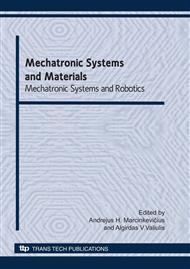p.265
p.271
p.278
p.285
p.291
p.297
p.303
p.308
p.313
Verification of Vibration Power Generator Model for Prediction of Harvested Power
Abstract:
This paper deals with modeling of a vibrational power generator and verification of a complex generator model for prediction of harvested power. The power generator is an electromagnetic device, which uses ambient energy of mechanical vibrations for generating useful electrical energy. This energy harvesting device constitutes a complex mechatronic system consisting of a resonance mechanism, electromechanical converter, power management (electronics and energy storage) and a powered device. When this system is placed in environment with sufficient mechanical vibration, the generator harvests energy and it can be used as autonomous source of electrical energy for powering of wireless sensors in remote applications. The verified simulation model of this device can provide a prediction of possible harvested power without any physical position of this device in a vibratory environment (only acceleration measurement is used as input).
Info:
Periodical:
Pages:
291-296
Citation:
Online since:
June 2010
Authors:
Price:
Сopyright:
© 2010 Trans Tech Publications Ltd. All Rights Reserved
Share:
Citation:


